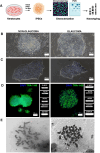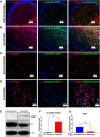Generation of Retinal Ganglion Cells from Reprogrammed Keratocytes of Non-Glaucoma and Glaucoma Donors
- PMID: 39781605
- PMCID: PMC11713219
- DOI: 10.1002/cpz1.70091
Generation of Retinal Ganglion Cells from Reprogrammed Keratocytes of Non-Glaucoma and Glaucoma Donors
Abstract
Human induced pluripotent stem cell (hiPSC)-based disease modeling can be successfully recapitulated to mimic disease characteristics across various human pathologies. Glaucoma, a progressive optic neuropathy, primarily affects the retinal ganglion cells (RGCs). While multiple groups have successfully generated RGCs from non-diseased hiPSCs, producing RGCs from glaucomatous human samples holds significant promise for understanding disease pathology by revealing patient-specific disease signatures. Given that keratocytes originate from the neural crest and previous reports suggest that ocular fibroblasts from glaucomatous donors carry pathogenic signatures, it is highly plausible that these signatures imprinted within the keratocytes will also be present in the derived RGCs. Thus, we aimed to generate RGCs from both glaucomatous and non-glaucomatous donor keratocytes and validate disease-specific signatures in 3D retinal organoids and in isolated RGCs. Our protocol describes the generation of iPSCs from keratocytes of both glaucomatous and non-glaucomatous donors, followed by their differentiation into retinal organoids. Subsequent isolation and culturing of RGCs were performed. Disease signatures in the RGCs were validated in both 3D retinal organoids (ROs) and 2D RGC cultures, and glaucomatous RGCs in 3D and 2D cultures demonstrated increased cleaved CASP3 and significant RGC loss, indicating disease imprints in the hiPSC-derived RGCs. This model offers a venue and high throughput platform for studying glaucomatous disease pathology and holds significant potential for drug discovery using RGCs derived from human donors. © 2025 The Author(s). Current Protocols published by Wiley Periodicals LLC. Basic Protocol 1: Culturing of keratocytes from human cadaveric donors Basic Protocol 2: Reprogramming donor keratocytes into iPSCs Basic Protocol 3: Evaluation of chromosomal loss during reprogramming in iPSCs by karyotyping Basic Protocol 4: Generation of 3D ROs Basic Protocol 5: Dissociation and culturing of RGCs from 3D ROs Support Protocol 1: Immunostaining for phenotypic characterization of cells Support Protocol 2: Sectioning of 3D ROs and immunostaining Support Protocol 3: Western blotting for cleaved CASP3 and THY1.
Keywords: glaucoma; induced pluripotent stem cells; keratocytes; retinal ganglion cells; retinal organoids.
© 2025 The Author(s). Current Protocols published by Wiley Periodicals LLC.
Conflict of interest statement
The authors declare no conflict of interest.
Figures





Similar articles
-
Culture Systems of Dissociated Mouse and Human Pluripotent Stem Cell-Derived Retinal Ganglion Cells Purified by Two-Step Immunopanning.Invest Ophthalmol Vis Sci. 2018 Feb 1;59(2):776-787. doi: 10.1167/iovs.17-22406. Invest Ophthalmol Vis Sci. 2018. PMID: 29392326
-
Stepwise Differentiation of Retinal Ganglion Cells from Human Pluripotent Stem Cells Enables Analysis of Glaucomatous Neurodegeneration.Stem Cells. 2016 Jun;34(6):1553-62. doi: 10.1002/stem.2356. Epub 2016 Mar 21. Stem Cells. 2016. PMID: 26996528 Free PMC article.
-
Continuous non-cell autonomous reprogramming to generate retinal ganglion cells for glaucomatous neuropathy.Stem Cells. 2015 Jun;33(6):1743-58. doi: 10.1002/stem.1987. Stem Cells. 2015. PMID: 25753398 Free PMC article.
-
Retinal ganglion cell death is triggered by paraptosis via reactive oxygen species production: a brief literature review presenting a novel hypothesis in glaucoma pathology.Mol Med Rep. 2014 Sep;10(3):1179-83. doi: 10.3892/mmr.2014.2346. Epub 2014 Jun 19. Mol Med Rep. 2014. PMID: 24969312 Review.
-
Glaucomatous optic neuropathy: Mitochondrial dynamics, dysfunction and protection in retinal ganglion cells.Prog Retin Eye Res. 2023 Jul;95:101136. doi: 10.1016/j.preteyeres.2022.101136. Epub 2022 Nov 16. Prog Retin Eye Res. 2023. PMID: 36400670 Review.
References
-
- Agarwal, D. , Dash, N. , Mazo, K. W. , Chopra, M. , Avila, M. P. , Patel, A. , Wong, R. M. , Jia, C. , Do, H. , Cheng, J. , Chiang, C. , Jurlina, S. L. , Roshan, M. , Perry, M. W. , Rho, J. M. , Broyer, R. , Lee, C. D. , Weinreb, R. N. , Gavrilovici, C. , … Wahlin, K. J. (2023). Human retinal ganglion cell neurons generated by synchronous BMP inhibition and transcription factor mediated reprogramming. NPJ Regenerative Medicine, 8(1), 55. 10.1038/s41536-023-00327-x - DOI - PMC - PubMed
-
- Bolinches‐Amoros, A. , Lukovic, D. , Castro, A. A. , Leon, M. , Kamenarova, K. , Kaneva, R. , Jendelova, P. , Blanco‐Kelly, F. , Ayuso, C. , Cortón, M. , & Erceg, S. (2018). Generation of a human iPSC line from a patient with congenital glaucoma caused by mutation in CYP1B1 gene. Stem Cell Research, 28, 96–99. 10.1016/j.scr.2018.01.004 - DOI - PubMed
MeSH terms
Grants and funding
LinkOut - more resources
Full Text Sources
Medical
Research Materials
Miscellaneous

